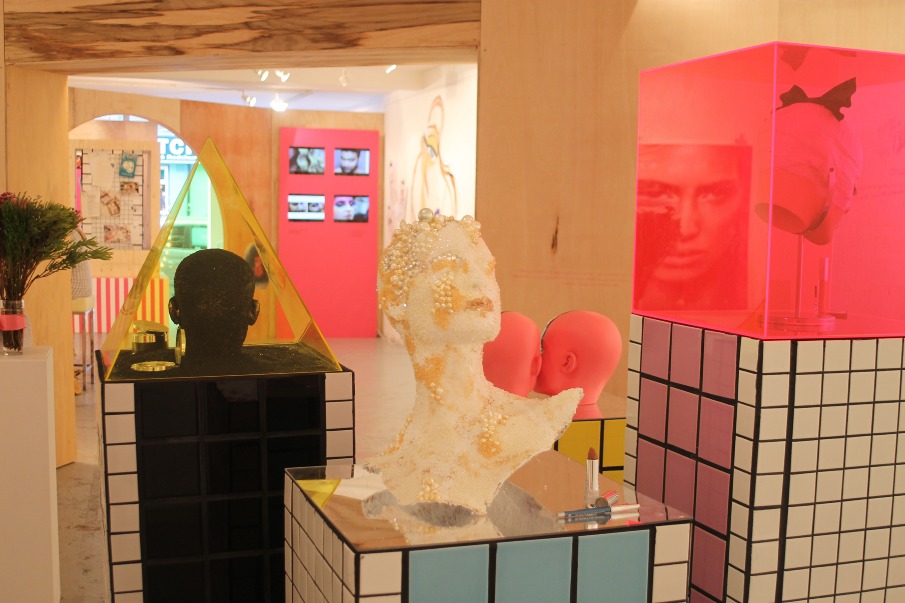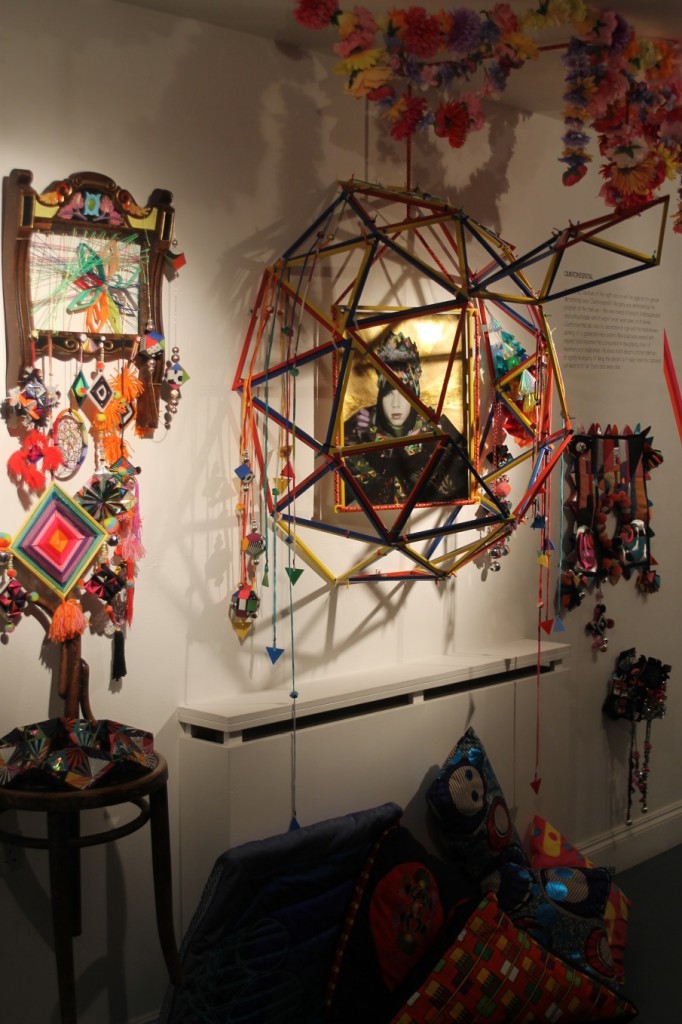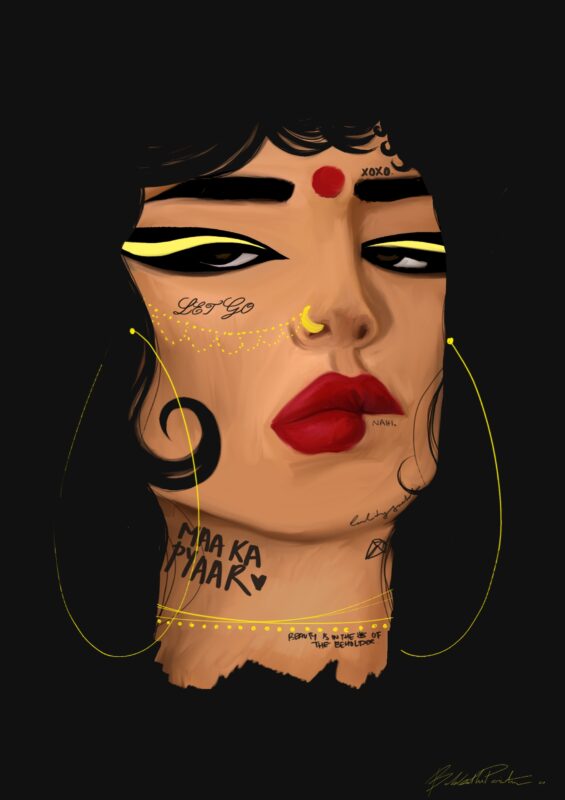
The first time I encountered Ryan Lanji was through his emails. Every so often I would receive colourful invites to exhibitions, primarily based in east London, as curated by the innately cool Lanji and his team. What initially struck me about these emails were Lanji’s decorous manner; polite and charming, I was keen to meet the man behind the penmanship. Suitably we met at Dalston Superstore, an eatery and club venue at the vanguard of social haunts, which had recently hosted Lanji’s two-part exhibition called Dalston Screen Tests and as the name evoked featured some of Dalston’s cultural figureheads using the conceptual framework of Andy Warhol’s iconic screen tests. Lanji’s other recent triumphs include Colour & Culture: Celebrating 40 years of Cosmetics a la Carte (2013), Alex Noble’s Creature’s From the Kaleidoscope (2013), Fred Butler’s Travelling Mac Fred on a Q-Tip for a tribe called guess (2014) as well as ongoing creative alliances with fashion designer Mary Katrantzou, stylist Kim Howells, set designer Alun Davies, artists Lorna May Wadsworth, Lexi Cinema and Dash Magazine.
Specialising in beauty as a form of contemporary art alongside endorsing fashion designers that work as visual artists, in the two years that Lanji has been in London his curatorial prowess has accrued a well-earned reputation and his exhibitions have been at the receiving end of much acclaim. With an artistic range that spans large-scale retrospectives of established design houses to solo and group shows of emerging and eclectic designers, Lanji’s own body of work is a spectacle of diversity and originality.



Lanji studied production at film school in his home city of Vancouver. The process of creating narrative-driven worlds interested Lanji but he was unconvinced that making movies was his ultimate vocation and so he paused and indulged in a summer “just enjoying my youth”. This marked a pivotal period as it was during this carefree episode that Lanji met a curator who asked him to lend a hand coordinating a retrospective of the Vancouver-based, fashion photographer Virginia Leeming’s work. Titled By Invitation Only, the 2009 exhibition unveiled Leeming’s reportage images from the frontiers of the Paris, Milan, London and New York biannual catwalk presentations since the early 1980s. Unafraid of the mammoth task, Lanji “got his hands dirty” and helped the curator with the entire show’s production. “It was then that I realised that I could use my skills as a film maker and enable all these hypothetical films to exist,” reveals Lanji. “Back then I didn’t know that I wanted to specialize in fashion specifically but four years later it’s really amazing to recall putting up Virginia Leeming’s pictures of Betsey Johnson doing the splits on the runway and Audrey Hepburn attending a fashion show and all these other candid moments that were completely honest and genuine.”
During that time Lanji had already made the decision to move to London, but it took several months and a treacherous situation to see him cross the threshold into a world where he would thrive. “When I arrived I didn’t know where to start as London is such a big city and I had never been here before, so I got a job at a pizza place but the night of my first shift I ended up getting mugged in Whitechapel. It was a horrid affair but really brilliant because the next day I called in sick to work because I was so shaken and instead I accompanied a friend to his interview at a gallery in Vyner Street. I ended up being a part of the interview and we both got a job. It was just to assist with an art prize but it was great because I wanted to get into curation and then afterwards they offered me a position as a weekend gallery manager. Soon after I curated my first fashion exhibition called Nailphilia (2011). The gallery had an open program and said we need a show for September and asked me if I could put one on for them, of course I said yes. So I was looking at London and the landscape of culture and I had a specific interest in fashion and it was then that I realise that nail art was buzzing, people were interested in it and it hadn’t really hit its full capacity. So I started doing research and invited nail artists to exhibit nails as contemporary art and before we knew it the best nail technicians in the UK were contributing. Nailphilia was one of the first nail art exhibitions in the world because no one had thought of it as a subject to look at.”
Following on from Nailphilia’s phenomenal success Lanji chose to focus on freelance commissions. So impressed with Nailphilia, Revlon, the beauty brand that invented nail enamel, approached Lanji to curate their 80th anniversary exhibition Enamoured: 80 Years of Revlon at the London Film Museum (2012). As Lanji shares, “Revlon were intrigued by Nailphilia and asked if I could tell their story, so I thought about it a lot and I really wanted to because there was nothing more affirming than doing a nail exhibition from your own head and having one of the biggest beauty brands in the world to invite you to champion their story. I really got to indulge in Revlon’s and Charles Revson’s [co-founder of Revlon along with his brother Joseph] entire history including things like their marketing campaigns. All those ads were so fascinating because Revlon were the first company to start that aesthetic of commercialised beauty, showing women what beauty was and how to feel and be beautiful. And it was during that time I started working with different creatives in east London.”

Since then Lanji has project managed over twenty exhibitions and events including book and magazine launches and installation works. Although he denies having a signature aesthetic, mainly because “the exhibitions are all so different”, he does cite an immersive quality that is recognisable in all his work. In terms of exhibition ideas, usually they stem from Lanji or Lanji’s interest in a particular artist and their body of work “I often approach someone and ask if they are working on anything specifically. If I am brought on board as a curator the visual aspect is discussed between myself, the artist and the gallery, but when it comes to initiatives that come from myself the visual aesthetic is catalysed by me, especially when they are shows I curate wholeheartedly. I am every part of the exhibition; the invite, the paper stock, the press release, even applying labels on the walls and making sure the prints are positioned in the right way are all down to me. I like everything run the right way, I never want there to be a missing link.”
Considering that Lanji’s focus straddles the disciplines of art and fashion, the elastic debate whether fashion is art, and on a close secondary level vice versa although this is often overshadowed by the former argument, is an open-ended and ongoing discussion. “There is an argument for both sides, some established designers say it is and some established designers say it isn’t, but I think the best way to challenge it and continue the conversation is to constantly do it. Fashion is a utilitarian garment by nature. Because there is a discourse of business and a discourse of its usage, people like to consider it a non-art form, but in the art industry art is the only thing that no one really needs but is one of the most valuable things in the world. There are so many different threads in that conversation as to who the artist is, what the piece is, how groundbreaking it is, and I think when you look at it in that respect that breakdown does happen in fashion as well. I think fashion is art when it’s not commodified. When it’s a singular piece in which the time and effort was put into it is just like a sculpture or a painting and is so intricate that it renders itself irreplaceable, then that is a moment where fashion is art.”
Future plans include designing an exhibition and organising a book launch for photographer Phil Maxwell’s images of Brick Lane’s street life and it’s transformation over the last thirty years. Both book and exhibition are aptly titled Brick Lane. Also in the planning stages is another beauty-based show scheduled for next year, “if it all goes to plan it will be so rewarding,” divulges Lanji enthusiastically before finally adding, “curators and historians and theorists by nature discuss any subject matter with a scholarly standpoint. I like to take things we find to be pop culture as well as trends and the fast and short lived and allow them to exist and allow people to know the story in a non-pretentious way. I don’t know how many people have gone to an exhibition and tried to read the text of the show and it goes over their head, so my approach is academic but still very accessible. I want anybody, from any walk of life, to walk away and know what was going on. My exhibitions need to be unforgettable. They are always experiential, I always want people to come and feel like they will never see something like that again.”


www.ryanlanji.com
WORDS: STEPHANIE TALBOT







